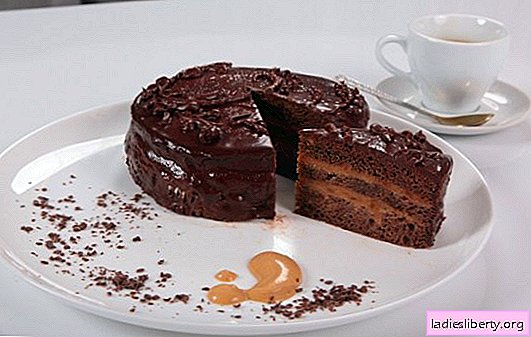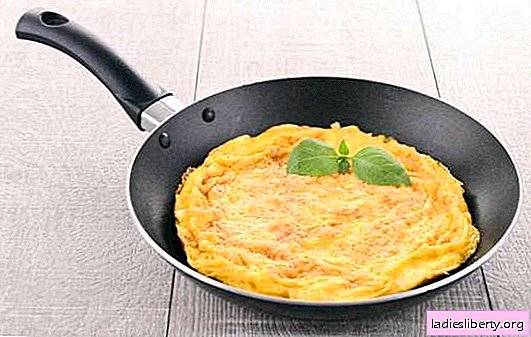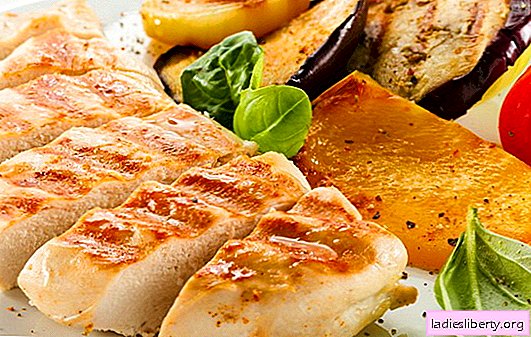
Those who are older remember the taste of the Prague cake well. According to GOST, it was also very tasty, and it was inexpensive - so you could afford to enjoy a chocolate and creamy dessert anytime you want. However, on the eve of the holidays for the cakes it was necessary to run to the grocery stores and stand in line, and attempts to buy a deficit for the holiday table were not always successful.
That's when our inventive housewives began to be interested in recipes for their favorite cakes, to try, to experiment. It also turned out very tasty, but the GOST requirements for Soviet housewives existed as a kind of parallel category of matching cooking technology, where the procedure for working on the cake was followed, but at the same time it was believed that home baking should have as much baking as possible: cream, chocolate, impregnation - all more, and to save on the prestige and fame of the best housewife was not accepted.
If according to the GOST recipe, it was necessary to soak the cake with ordinary sugar syrup with the addition of essences, then in the home kitchen the biscuit should be soaked with the best cognac, liquor or rum. As now, in Soviet times, GOST requirements were strictly regulated by economic feasibility. At home craftswomen, the requirements for a dessert of their own manufacture have always been and remain much higher, and therefore the abbreviation "GOST" is appropriate for only one recipe for the cake "Prague" or any other confectionery product of the Soviet era, which was included in the honorary list of sweets subject to mandatory state standardization.
By the way, the confectioner of the Moscow restaurant "Prague", who developed the recipe for the cake, could not register its invention in its original form due to the requirements of GOST - the recipe was changed for mass production so that only the name and some external similarity remained from the cake. In the days of the lack of the Internet, finding the right recipe was not easy, and every culinary invention was retold and transmitted, as a work of oral folk art, at one time; professional confectioners were not very willing to share the secrets of the enterprises in which they worked, and therefore there are different versions of almost every cake created in the Soviet era.
Consider several options for its preparation. Who knows, maybe someone will be able to come up with another, more advanced cake "Prague". Creative thought cannot be limited by either GOST or other frameworks of dull monotony.
Cake "Prague" according to GOST - basic technological principles
The preparation of each confectionery is based on rules that cannot be circumvented, because by stepping back from them one can simply spoil the product. These rules are regulated not by GOST, but by the laws of biochemistry and physics. If the recipe says that the biscuit dough increases in volume when whisking, then you can not deviate from this rule. This is an example. But at certain stages of cooking, you can still make your own ideas and adjustments when you are sure that they will not affect the quality of the product badly. Now we move on to the basics of making the Prague cake.
In each version of the Prague cake recipe, there is a similarity. Each cake consists of a base - cake, impregnation - syrup, which gives the cake moisture and flavor, cream - they connect the cake with each other, and glaze, fudge or cream (sometimes - jelly, fruit, nuts, etc.), which decorate surface of the cake. That is, the preparation is conditionally divided into four stages. Since each stage is technologically unrelated to the others, for example, for chocolate biscuit, you can make chocolate fudge instead of glaze, or replace the prescription syrup for soaking. It is important that during the preparation of the cake were not violated:
basic technological requirements - the use of the necessary utensils, compliance with the temperature regime, the rules of mechanical and heat treatment;
requirements for the quality of products - for the manufacture of some types of confectionery it is very important to use only fresh products of the highest quality, and their replacement with cheaper components leads to damage to the product;
the proportions of the components were strictly observed - humidity, fat content, density, taste of the dough play a decisive role in the final product.
The basis of the cake "Prague" according to GOST - butter biscuit. If flour, sugar and eggs are part of a regular biscuit dough, then butter is added to the dough biscuit dough, respectively. In addition, there are recipes for biscuit dough on water, with the addition of starch, cocoa (chocolate biscuit), zest, vanilla, various fruit essences, dried fruits, nuts.
If the requirements of GOST are not fundamental, then at the stage of preparing the biscuit dough, you can, having preserved the chocolate look and taste of the biscuit, try the option of a more fluffy biscuit dough on starch, replacing it with part of the flour. If the biscuit dough is cooked in water, then, accordingly, it is necessary to reduce the number of eggs added to the dough.
The butter in the biscuit dough not only increases the fat content and calorie content, but also makes it more tender, retains moisture, and therefore the butter biscuit does not stale for a long time. But too much oil makes the biscuit crumbly.
When complying with the biscuit dough recipe, it is also important to pay attention to whipping, during which the dough increases significantly in volume. It is saturated with air bubbles during mechanical action (whipping). At the same time, the chemical processes occurring in it are also important, and they, in turn, depend on the content of gluten in the flour, its moisture content, freshness and temperature of egg white, the amount of sugar and oil added.
The next, no less important stage is baking. The temperature and baking time depend on the thickness of the biscuit layer, the humidity of the dough, which cannot always be measured. Therefore, recipes always indicate the average temperature and duration of baking. At this stage, experience is an indispensable thing when a confectioner can determine readiness by the appearance of a biscuit dough.
Place the biscuit dough pan in the center of the oven to ensure uniform heating. The temperature should be average so that the surface of the cake does not bake before moisture has evaporated from the middle of the formation. It is strictly forbidden to shake the finished dough, open the oven door in the first 15-20 minutes of baking, until you see a uniformly baked surface through the glass of the door. When you see the light brown surface of the biscuit, you can open the cupboard and check the readiness of the cake with a wooden stick, skewer, toothpick or match.
The finished biscuit in the form is placed on the wire rack (!) Until it cools completely. Why is it necessary to put on the grill? The bottom of the mold should also cool evenly, so that the bottom of the cake does not become wet due to the formation of condensation, if air is not provided to the bottom of the hot mold.
The cooled cake is cut into three identical layers and soaked in syrup. After the layers are collected and glued with cream. The top of the cake is covered with jam. This is done in order to align the upper layer, and also so that fudge or chocolate icing does not drain down until it completely hardens. The finishing touch is the decoration of the cake.
Now let's move on to the recipes in order to practice the confectioner's skills in practice and find out which confectionery techniques and tricks can be used in the preparation of the Prague cake.
1. Original cake "Prague" in accordance with GOST
For chocolate butter biscuit:
Eggs (1 cat.) 680 g (10 pcs. Without shell)
Sugar 278 g
Oil (Extra) 76 g
Vanilla powder, crystalline 1.5 g
Flour 232 g
Cocoa (100%) 46 g
For impregnation (*):
Sugar Syrup 15 g
Water 75
Cognac essence 10 mg
For cream:
Oil (82.5%) 400 g
Condensed milk (8.5%) 240 g
Yolks (1 category) 72 g (4 pcs.)
Vanillin 2 g
Water 72 ml
Cocoa Powder (99.9%) 20 g
For chocolate fudge:
Refined sugar 160 g
Water 54 ml
Lemon juice (*) or citric acid solution (15%) 5 mg
Additionally:
Cocoa (for powder fondant layer) 10 g
Apricot jam 75 g - for lubrication of the upper cake, under the fondant layer
Sponge cake for dusting the sides - 100 g (+/- 25 g)
(*) - optional components. In the recipe according to the requirements of GOST, the components marked with an asterisk are absent, since they significantly increase the cost of the finished product. The food industry in the USSR, and especially the bakery, bakery, and confectionery industries received subsidies from the state budget, and therefore saving budget funds was one of the main tasks of state standardization. Lemon juice in this recipe is indicated for a comparative determination of acidity, and impregnation is used to improve the quality of the biscuit in the finished product.
In the Prague cake recipe invented by the restaurant pastry chef, brandy and syrup were originally indicated as impregnation, but the very first and original recipe was simplified for the reasons already indicated. GOST in the days of the USSR also played the role of a kind of patent office, with the right to dictate to the author of the invention what changes should be made to its opening, so that it would later be introduced into production.
Cooking Technology:
Preheat the oven to 180 ° C and cook a round split mold, greasing it with cooking oil. Line the bottom of the mold with greasy parchment paper.
Divide the cooled eggs into yolks and squirrels. Rub half of the sugar taken for the test with the yolks until white. In a clean and dry bowl, whisk the whites to a stable foam, adding sugar at the end of the whipping. Continue whipping the proteins until sugar is dissolved. Transfer the finished protein mass into a bowl with yolks, one spoonful, carefully mixing the egg mass with a wooden or silicone spatula.
Take another clean bowl and whisk the softened butter in it. Transfer it just as carefully into a bowl of eggs.
Sift flour and cocoa. Add vanillin to the dry mixture, and then pour it into the total mass. Sift through a sieve, mix gently so that lumps do not form and the dough does not settle.
Gently shift the dough into shape, trying not to make sudden movements. Put in the oven immediately.
After 30-35 minutes, you can check the readiness of the biscuit without getting it. Open the door and pierce the cake with a wooden stick. If it turns out to be dry, then the biscuit is ready. Place the cake pan on the wire rack. The perfect biscuit should last 8-10 hours. After it is taken out of the mold, the parchment is removed, cut into three identical layers, horizontally.
Sugar or syrup syrup is mixed with cognac, water in a ratio of 2: 1: 1 to soak cakes. After spraying syrups, keep the cakes on the desktop for a couple of hours, decomposing them separately.
Cooking cream "Prague":
In a bowl, combine the yolks with the same amount of water. Add the condensed milk, mix and boil (preferably in a water bath) until the consistency of sour cream. After cooling the mass, add oil to it, beat until stable peaks, add sifted cocoa powder and vanillin.
Collect the cake by spreading evenly each layer of biscuit with cream, dividing the cream into 3 parts. Leave one part of the cream to lubricate the side surface of the cake and design the picture - the border on the top layer.
Cook fondant from sugar, cocoa and water. Dissolve the sugar combined with cocoa in hot water and boil the syrup, adding acid at the end of cooking to avoid sugaring the fondant.
Continue to assemble and decorate the cake:
Lubricate the sides of the cake with cream.
Sprinkle sponge crumbs on top of the cream.
Cover the top cake with a thin layer of jam.
With warm fudge, grease the surface and sprinkle it with cocoa powder. To distribute the cocoa layer evenly, use a strainer.
From the pastry bag along the edge of the cake, drop the curb using the sprocket nozzle. To do this, place the cake on a rotating stand and squeeze the cream, making wave-like movements with your right hand, while rotating the stand with your left hand. In the center of the surface write the name of the cake.
Ready cake should stand at least 5-6 hours before use.
2. Prague cake according to GOST: the option of replacing butter in a biscuit
If for some reason you need to change the composition of the biscuit, while maintaining its maximum similarity with the original recipe, then for the preparation of biscuit you can use the following composition of products:
For biscuit:
Eggs 8 pcs.
Flour 260 g
Cocoa (powder) 50 g
Spread 60% 125 g
Sugar 250 g
Vanillin 2.5 g
Ingredients for cream and fudge - recipe number 1
Cooking Technology:
Separate half of the taken sugar to beat the spread. Considering that instead of premium oil in this biscuit, a spread with a lower fat content and high moisture content is used, then to prepare the dough, you need to reduce the number of eggs and add flour to balance the dry and wet components of the dough. Reducing the egg content in the test, you also need to proportionally reduce the amount of sugar.
The further preparation procedure is according to prescription No. 1.
3. Cake "Prague" according to GOST: a quick way to cook
Favorite dessert can be prepared even when there is practically no time left before the guests arrive. Fortunately, in every supermarket biscuit semi-finished products are sold, which, like cakes, are made in accordance with GOST. There you can buy the rest of the workpiece.
Ingredients:
Chocolate sponge cake 500 g
Custard (dry mix such as "shallot") 100 g
Extra oil 200 g
Milk 300 ml
Cocoa 10 g
Jam 70 g
Fudge and syrup for impregnation - according to the recipe No. 1
Biscuit crumb, powder
Cooking Technology:
Soak the finished biscuit in syrup, dividing into three layers. Pour custard into a bowl, dilute with milk and cook. Follow the instructions, but if you want, you can add cognac and vanillin at the end of cooking to enhance the aroma. Add the softened butter to the cooled cream and beat.
Collect the cake as described in the main recipe (see above).
4. Prague cake according to GOST: how to replace condensed milk in a cream?
Sometimes it happens that the work is in full swing, but suddenly it turns out that the necessary ingredient is not available. Difficulties temper the character, therefore, without getting lost, we prepare the condensed milk for the cream, choosing the easiest way. In order not to lose a lot of time, we combine the preparation of condensed milk, gradually moving to the cream.
So, replacing the ingredients in the cream without violating the requirements of GOST:
Butter
Yolks
Vanillin
Water 250 ml
Cocoa
Powdered milk or cream (10%) 180 g
Sugar 150 g
Cooking:
The amount of butter, yolks, vanillin and cocoa for the cream remains unchanged (see recipe No. 1). The technology for preparing the cream changes slightly:
Combine sugar, cocoa and milk powder;
Add 180 ml of water to the mixture, whisk;
Beat the rest of the water with the yolks. Continuing the whipping, combine the egg and milk mass;
Cook in a water bath until thickened. At the end of cooking, add vanillin and leave the cream to cool.
Beat the chilled custard and butter until tender.
You can also replace condensed milk in a cream with whole milk (180 ml) with added sugar (150 g).
Five.GOST cake "Prague": dry mix for biscuit
It is no secret that large-scale confectionery has long used dry mixtures that can increase productivity, more effectively resolve issues related to sanitary requirements.
Dry egg powder can often be found in retail, and in some cases, such a purchase is useful. Moreover, egg powder is more sanitary than fresh eggs. When used in a biscuit test, a more stable foam is obtained.
Try making biscuit dough using egg powder.
For biscuit:
Egg white, dry (albumin) 22 g
Dry yolk 74 g
Water 154 ml (for protein) + 95 ml (for yolk)
Powder
Flour
Cocoa
Butter
Vanillin
Cooking:
For cakes based on dry egg powder, all the other ingredients of the biscuit for the Prague cake according to GOST are taken in the same amount as indicated in the first recipe.
Albumin is dissolved in cold water, left to swell, and then beat with a mixer at high speed until a stable foam is formed, adding 1/3 of the sifted powder at the end. Dry egg yolk is dissolved in warm water (its amount is indicated in the list of ingredients separately). Temperature - 25-30 ° C. Then the dry powder is also whipped by adding powder. Further cooking - according to GOST technology.
6. Cake "Prague" according to GOST: decoration options
One of the decoration options is described in the first recipe, but there are also other methods using chocolate glaze. Slight deviations from the standard requirements regarding the design of the Prague cake are allowed by GOST, but the pattern on the surface is still in chocolate. For the second design option, chocolate icing is required: it is less difficult to prepare than fudge, and therefore home confectioners can use the simplest recipe for decorating the Prague cake before gaining experience.
For chocolate glaze:
Milk (3.2%) 150 ml
Oil (82.5%) 75 g
Sugar 220 g
Cocoa (99.9%) 50 g
Vanillin 6 g
Cognac 35 ml
Cooking:
Combine the sugar and cocoa powder, pour in the milk and bring the mixture to a boil. Next, cook until thickened over low heat, and so that the chocolate does not burn, put the pan in a water bath. To prevent the formation of a crust, put in oil. Stir chocolate occasionally. Before removing it from the stove, add vanilla powder. Beat with a spatula. When whisking, add brandy to shine and flavor the glaze.
Please note that milk with sugar and cocoa must be boiled until the syrup is thick so that the chocolate glaze freezes well on the surface of the cake.
To apply the pattern, warm glaze is placed in a cornet made of parchment, and a chocolate net is drawn on top of the fondant layer.
The second option: the surface is covered with chocolate icing, on a layer of apricot jam. The icing cake is placed in the refrigerator, and then the chocolate pattern is applied with the same icing, the inscription is made: "Prague".
Third option: a pattern is applied on the back of the parchment. Parchment is laid out on a metal sheet (dish or baking sheet). From the cornet, a pattern is applied using glaze, which is visible through a transparent sheet of paper. It is better to pre-cool the metal tray in the freezer so that the pattern does not spread. After drawing the drawing, transfer the pallet back to the cold, and when the chocolate hardens, carefully separate the pattern from the paper and lay it on the cake.
Cake "Prague" according to GOST - useful tips and tricks.
Making a cake takes a lot of time, especially when there is not enough experience. Divide the whole process into separate steps:
Prepare a biscuit in one day - this work will take no more than an hour, including baking time. Ready cake should be aged for 8-10 hours, as already mentioned. It can be prepared the day before, in the evening. Ready-made biscuit cakes, in sealed packaging and without cream, can be stored in the refrigerator for up to 5-7 days, without loss of quality.
The prepared chocolate fudge perfectly retains its qualities in a jar, on the shelf of the refrigerator for a month, if you do not eat it earlier, preparing sandwiches for tea.
You can also prepare chocolate icing in advance, but it must be stored at moderate humidity and temperature.
Cream is the only component of the cake that cannot be stored for more than 36 hours. That is, on the day when you need to serve a cake to the table, it will be enough to prepare the cream and collect it.











